标签:tar image counter context 子进程 因此 single esc bee
图片版在这:https://www.cnblogs.com/pdev/p/10576835.html
上完5103其实就该总结一下的......还是懒 (呵
1. 进程栈
函数调用时,函数参数、返回地址、环境、函数内非static的局部变量存入栈。(栈空间是专门留给函数用的)
程序内所有malloc/new出来的空间、全局变量、所有的static变量存入堆。
(Ref:https://www.cnblogs.com/pdev/p/11289870.html)
堆是从低地址向高地址增长的,栈相反。参考下图
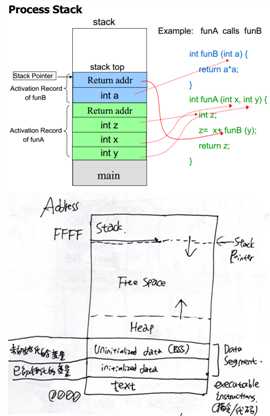
2. 内核态和用户态、system call
User programs are typically executed in user mode. In user mode, program cannot control devices or access memory address directly. All privileged operations should be executed by using system call. A user program executes in the USER mode and it is given limited privileges. Region of memory it can access is restricted. It cannot execute certain instructions such as HALT or setting or changing timers. It cannot directly access any I/O devices or network ports. The primary reason is to protect the system and other user processes and the file system from a misbehaving program.
Kernel code is trusted to be safe and correct. This code is executed in Privileged/Supervisor Mode. It can execute any operation (i.e. instruction). A user process executes the kernel code by making a system call.
System Call的全过程:

System Call和普通函数调用(procedure call)的对比:
system call:
1. Push all parameters into user mode stack
2. put the code of system call into CPU register (in other words, call this procedure)
3. execute a trap instruction, so it will start executing in kernel mode at a fixed address.
4. kernel code will be dispatched to a system-call handler, and the system-call handler runs in kernel mode.
5. After the kernel code finished, switch back to user mode and return to the instruction following TRAP in system call library procedure.
6. After the system call finished, return to user program.
7. The user program will clean up the parameters of system call in the stack, and user program continues.
procedure call:
1. Push all parameters into user mode stack
2. put the code of procedure call into CPU register (in other words, call this procedure)
3. execute the procedure in user mode
4. After procedure call finished, return to user program.
5. The user program will clean up the parameters of system call in the stack, and user program continues.
The procedure call does not need to switch betweenuser mode and kernel mode, so it will save time
Interrupts & exceptions & System calls & traps
Interrupts source: External devices (eg: finish I/O operation on hard disk). Goal: CPU could work in parallel with devices
Exceptions source: Errors in CPU when executing instructions. Goal: Handle internal errors in CPU (eg: divided by zero)
System calls source: Program manually call system call functions provided by operating system. Goal: Execute features which needs OS support (eg: I/O)
Traps source: TRAP instruction in program. Goal: Transfer from user mode into kernel mode
fork()函数
1.Only the thread who called fork() will be forked to new child process. So the child process only have 1 thread.
2.The child process will copy all the memory data from its parent process. Then they will run as independent processes. In modern operating systems, they will do
copy-on-write in fork(), which means both parents and child will receive a read-only copy of the parent‘s data space, instead of copying the whole data in the first
place. The copy will actually occur when one of them want to modify some data.
3.Based on (2), mutex variables will be copied into child process. Suppose we added locked a mutex before fork(). After fork(), the mutex in the child process will
remain locked, and there will be only one thread in the child process, which means this mutex in child process will never be unlocked(and this is called deadlock). Even if we unlocked mutex in parent process, the one in child process will not be modified.
4.Based on (2), File descriptors will be copied into child process. So they will have the same file pointer, which will point to the same file table. Thus the file status
opened in both processors(include their filename, current file offset) are shared.
clone()函数
Linux provides a more powerful function than fork for creating a new process or thread.
• It can be used to create a new process as in case of fork.
• It can also be used to create a new thread in the address space of the calling process.
进程的上下文切换(略)
进程和线程的区别
A process represents one single sequential activity. – one execution context (Program counter and stack)
A thread represents one activity -- one context and stack per thread.
All Threads of one process can share resources such as memory, open files, and communication channels.
All threads in a process share the following items:
– Address space
– Global variables
– Open files / resources
– Child processes
– Signals and signal handlers
– Accounting Information
Thread specific items:
– Program counter and registers (execution context)
– Stack
– Execution state (ready, waiting, running)
进程之间私有和共享的资源
线程之间私有和共享的资源
进程/线程之间的通信方式总结

进程之间的通信方式以及优缺点 管道(PIPE) 有名管道:一种半双工的通信方式,它允许无亲缘关系进程间的通信 优点:可以实现任意关系的进程间的通信 缺点: 长期存于系统中,使用不当容易出错 缓冲区有限 无名管道:一种半双工的通信方式,只能在具有亲缘关系的进程间使用(父子进程) 优点:简单方便 缺点: 局限于单向通信 只能创建在它的进程以及其有亲缘关系的进程之间 缓冲区有限 信号量(Semaphore):一个计数器,可以用来控制多个线程对共享资源的访问 优点:可以同步进程 缺点:信号量有限 信号(Signal):一种比较复杂的通信方式,用于通知接收进程某个事件已经发生 消息队列(Message Queue):是消息的链表,存放在内核中并由消息队列标识符标识 优点:可以实现任意进程间的通信,并通过系统调用函数来实现消息发送和接收之间的同步,无需考虑同步问题,方便 缺点:信息的复制需要额外消耗 CPU 的时间,不适宜于信息量大或操作频繁的场合 共享内存(Shared Memory):映射一段能被其他进程所访问的内存,这段共享内存由一个进程创建,但多个进程都可以访问 优点:无须复制,快捷,信息量大 缺点: 通信是通过将共享空间缓冲区直接附加到进程的虚拟地址空间中来实现的,因此进程间的读写操作的同步问题 利用内存缓冲区直接交换信息,内存的实体存在于计算机中,只能同一个计算机系统中的诸多进程共享,不方便网络通信 套接字(Socket):可用于不同及其间的进程通信 优点: 传输数据为字节级,传输数据可自定义,数据量小效率高 传输数据时间短,性能高 适合于客户端和服务器端之间信息实时交互 可以加密,数据安全性强 缺点:需对传输的数据进行解析,转化成应用级的数据。 线程之间的通信方式 锁机制:包括互斥锁/量(mutex)、读写锁(reader-writer lock)、自旋锁(spin lock)、条件变量(condition) 互斥锁/量(mutex):提供了以排他方式防止数据结构被并发修改的方法。 读写锁(reader-writer lock):允许多个线程同时读共享数据,而对写操作是互斥的。 自旋锁(spin lock)与互斥锁类似,都是为了保护共享资源。互斥锁是当资源被占用,申请者进入睡眠状态;而自旋锁则循环检测保持者是否已经释放锁。 条件变量(condition):可以以原子的方式阻塞进程,直到某个特定条件为真为止。对条件的测试是在互斥锁的保护下进行的。条件变量始终与互斥锁一起使用。 信号量机制(Semaphore) 无名线程信号量 命名线程信号量 信号机制(Signal):类似进程间的信号处理 屏障(barrier):屏障允许每个线程等待,直到所有的合作线程都达到某一点,然后从该点继续执行。 线程间的通信目的主要是用于线程同步,所以线程没有像进程通信中的用于数据交换的通信机制
Process Control Block
存储了以下信息:
Process state Number
User ID, accounting info, scheduling priority
Process context
Memory info, page tables
Open files, current /root dir
Pending signals and I/O
3. Scheduling Algorithm(略)
4. 临界区、信号量、死锁
进程的几种状态:
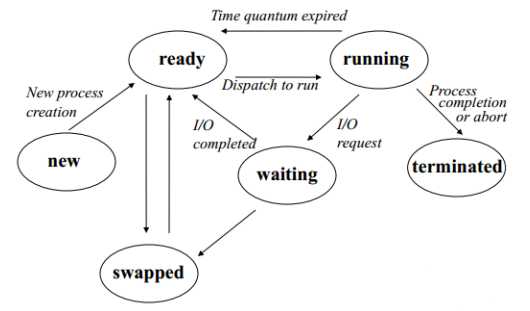
New – process is being created and initialized
Running – currently executing
Ready – waiting to get CPU to become running
Blocked – waiting for some event, such a I/O completion
Swapped – partially executed, and its memory image has been stored on the disk
Terminated – process has completed due to normal or abnormal exit.
sleep: A process executing a system call may go to sleep to wait for a resource.
wakeup: When the resource is available it is awakened
注意区分两个概念:
忙等待(busy-waiting): while(i!=1) {…} 消耗 CPU
阻塞等待(blocked-waiting): 挂起,不消耗 CPU
临界区:同时只有一个进程可以访问的资源。为了互斥访问临界资源,每个进程在进入临界区之前,需要先进行检查。
A sequence of code is called CRITICAL SECTION has the following properties: Mutual exclusion Property : At any time, at most one process can be executing the critical section code. In general, updates to shared data structures are performed in a critical section.
信号量
The motivation was to avoid busy waiting by blocking a process execution until some condition is satisfied.
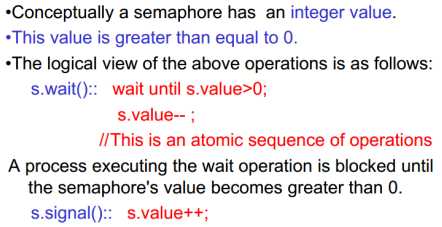
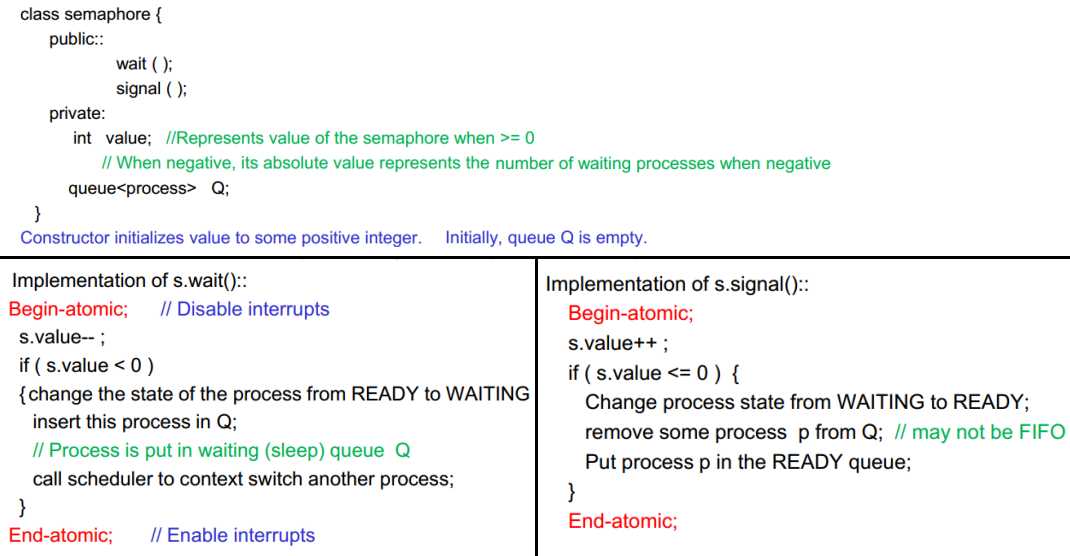
Binary Semaphore:value取值只能取0和1。0 表示临界区已经加锁,1 表示临界区解锁。

经典的信号量同步问题
1111111111111
死锁
死锁的发生条件:
预防死锁的方法
银行家算法:避免死锁。在进程申请资源时,检查申请的合理性。只有不导致死锁的申请才被认可。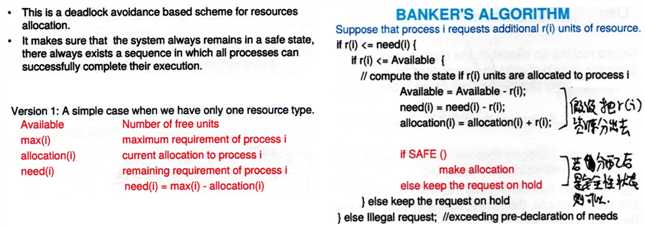
安全性算法:由银行家算法改进更通用的安全性算法。用于multiple resource type的情况。
Ref:https://blog.csdn.net/Caoyang_He/article/details/80819411
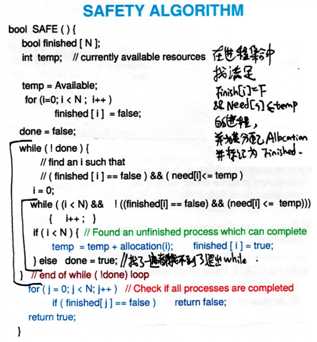
管程(monitor)
略
5. 内存管理
Paged memory management:eliminates fragmentation by non-contiguous allocation
页表的结构
程序中使用的地址都是逻辑地址(Page Number和Offset)。CPU想访问某内存空间时,首先在TLB(相当于一个页表的cache)中找页号对应的页框号。如果找到了就直接去物理内存读该页框的内容。如果没找到就进入页表找,然后得到页框号和物理地址(Frame Number+Offset),再去读物理内存。
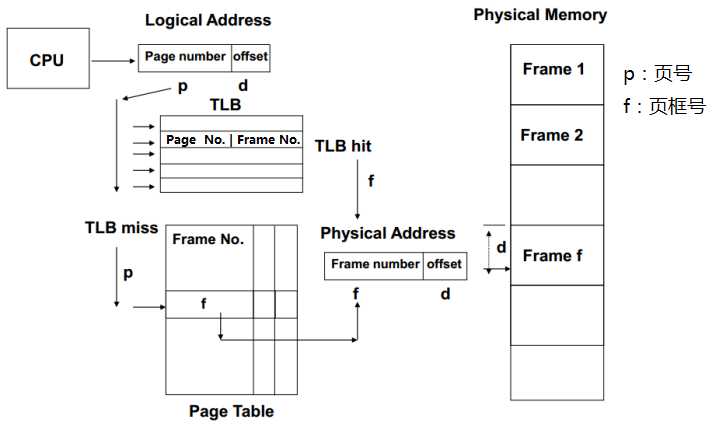
Page Fault:物理内存空间是有限的,所以引入虚拟内存的概念。当程序试图访问的内存地址现在不在物理内存中时,就会发生Page Fault。此时系统会TRAP(进入内核态,并由系统将对应的内存页从虚拟内存载入物理内存)。过程如下图:
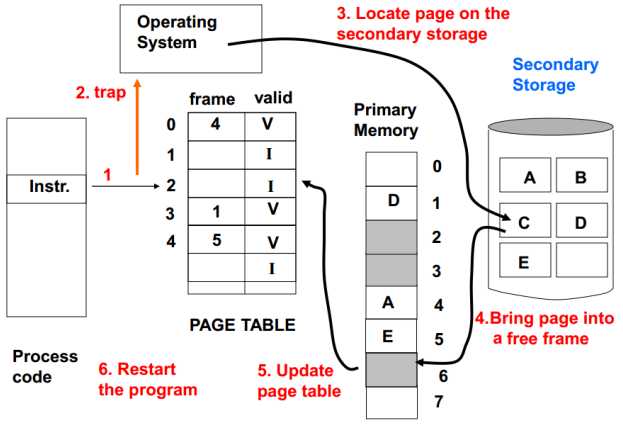
页面置换算法:内存满时用于选出要放入虚拟内存的页面。(略)
当页表太大时需要分成多级页表。
二级页表:第二级页表可以按需要动态调入,从而节省空间 
Working Set
The memory references generated by a program over some period of time tend to be confined to some small number of pages which reflects its "locality" during that execution phase. Try to maintain the pages which belong to the current working set (locality). Working set is estimated based on a time window of execution instead of some number of memory references. Parameter t defined as a time window. Working-set algorithm removes page p from then working-set if age(p) > t
程序在一段时间内访问的内存块集中在特定的几块。因此可以记录最近(某个time window内)用过的k个Page,保证它们不会被置换出去。
分段内存管理(略)
分段和分页的比较
对程序员的透明性:分页透明,但是分段需要程序员显式划分每个段。
地址空间的维度:分页是一维地址空间,分段是二维的。
大小是否可以改变:页的大小不可变,段的大小可以动态改变。
出现的原因:分页主要用于实现虚拟内存,从而获得更大的地址空间;分段主要是为了使程序和数据可以被划分为逻辑上独立的地址空间并且有助于共享和保护。
6. IO、文件系统
Polling: busy waiting until device finish
Interrupt: 用中断处理,但频繁中断占用太多 cpu
DMA:传输一大段才 interrupt,而不是每个 word/byte 都中断
1. CPU sets up the DMA controller register to handler DMA transfer from a disk to memory.
•Number of bytes to be transferred
•Memory address where to transfer the data.
2. DMA controller issues a request to disk controller read the next block in its buffer and write to a memory address.
3. Disk controller reads disk block in its buffer, and writes it to memory buffer.
4. After writing the block to the memory, the disk controller “acks” the DMA controller, which then decrements the count, increases the memory address, and goes to step 2 if
the count is greater than 0.
5. DMA controller interrupts the CPU when the count reaches 0.
Disk && Disk Storage Management(略)
Concurrent Access to Files
On Unix system:
•Writes to an open file are visible immediately to other users that have this file open at the same time.
•When a process forks a child, a file open at the time of fork is shared with the child. Both parent and the child share the file position pointer
inode
Ref:https://blog.csdn.net/xuz0917/article/details/79473562
文件存储在硬盘上,硬盘的最小存储单位叫做“扇区”(Sector)。每个扇区储存512字节(相当于0.5KB)。操作系统读取硬盘的时候,不会一个个扇区的读取,这样效率太低,而是一次性连续读取多个扇区,即一次性读取一个“块”(block)。这种由多个扇区组成的“块”,是文件存取的最小单位。“块”的大小,最常见的是4KB,即连续八个sector组成一个block。
文件数据都储存在block中,那么很显然,我们还必须找到一个地方储存文件的“元信息”,比如文件的创建者、文件的创建日期、文件的大小等等。这种储存文件元信息的区域就叫做inode,中文译名为”索引节点“。每一个文件都有对应的inode,里面包含了与该文件有关的一些信息。如图所示
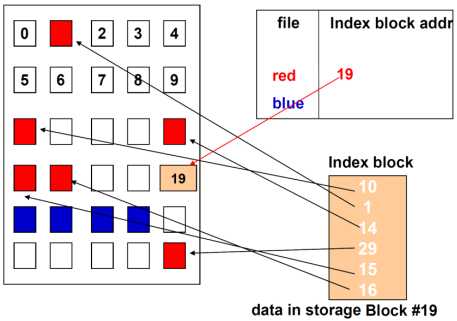
The addresses of all storage blocks of a file are recorded in one (or more) "index block". This block is maintained on the disk and is accessed through the directory entry. When a file is opened, this block is read into memory. Once this block is in memory, any block of the file can be accessed directly
Unix的iNode是一个多级的索引结构。如下图,
Suppose that file-block size is 4KB. The first 10 direct pointers will point first 40KB of the file.
Suppose that the first level indirect block has 128 pointers. (设32bit pointer,4KB/32bit=128)
Then, with the block size of 4KB, we can now address additional 128*4KB, i.e. about 0.5 MBytes.
For a file larger than that, the INODE contains the second level indirect blocks. This block has pointers (128) for 128 first level indirect blocks, each of which points to data blocks of 0.5 MBytes. Thus by using the second level indirect pointer, we can now store additional 64 MBytes in the file.(128*128*4KB)
With third level indirect block we get file size close to 8GB. (128*128*128*4KB)
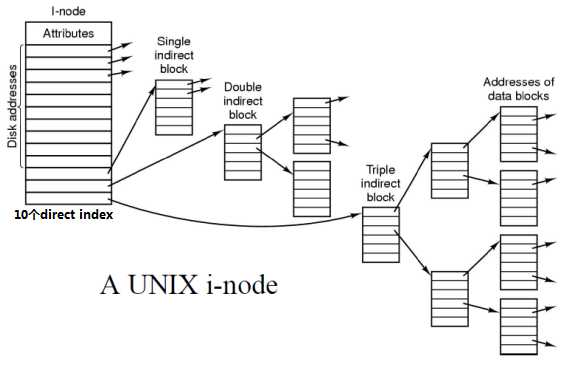
文件夹也有inode。访问文件夹时,先访问该文件夹的iNode,然后顺着iNode找该文件夹所在的block。

| Symbolic Linking(符号链接/软链接) | Hard-Link(硬链接) | |
|
类似Windows的快捷方式,只记录源文件的位置。 是个独立的文件,占用空间 |
与源文件指向相同的iNode,不占用空间。 源文件的所有hard link都被删除时,源文件才真正被删除。iNode keep count of hard links. |
|
| Pros |
可以为文件夹创建symbolic link 源文件可以在不同的文件系统。 |
可用来保护源文件 |
7. Security (略)
8. Virtual Machine(略)
9. 一些补充知识点
Ref:
https://github.com/CyC2018/CS-Notes/blob/master/notes/%E8%AE%A1%E7%AE%97%E6%9C%BA%E6%93%8D%E4%BD%9C%E7%B3%BB%E7%BB%9F%20-%20%E7%9B%AE%E5%BD%95.md
https://github.com/huihut/interview#-%E6%93%8D%E4%BD%9C%E7%B3%BB%E7%BB%9F
主机字节序与网络字节序
主机字节序又叫 CPU 字节序,其不是由操作系统决定的,而是由 CPU 指令集架构决定的。主机字节序分为两种:

各架构处理器的字节序
网络字节顺序是 TCP/IP 中规定好的一种数据表示格式,它与具体的 CPU 类型、操作系统等无关,从而可以保证数据在不同主机之间传输时能够被正确解释。网络字节顺序采用大端(Big Endian)排列方式。
大内核和微内核
大内核
大内核是将操作系统功能作为一个紧密结合的整体放到内核。由于各模块共享信息,因此有很高的性能。
微内核
由于操作系统不断复杂,因此将一部分操作系统功能移出内核,从而降低内核的复杂性。移出的部分根据分层的原则划分成若干服务,相互独立。在微内核结构下,操作系统被划分成小的、定义良好的模块,只有微内核这一个模块运行在内核态,其余模块运行在用户态。因为需要频繁地在用户态和核心态之间进行切换,所以会有一定的性能损失。
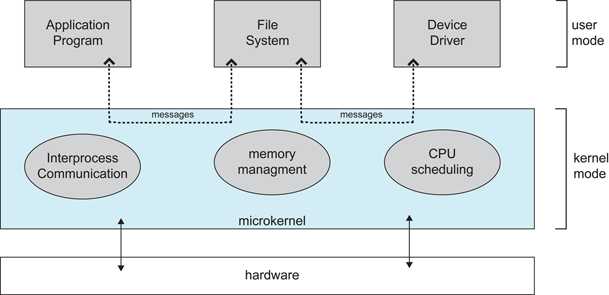
编译系统
以下是一个 hello.c 程序:
#include <stdio.h>
int main()
{
printf("hello, world\n");
return 0;
}
在 Unix 系统上,由编译器把源文件转换为目标文件。
gcc -o hello hello.c
这个过程大致如下:
静态链接
静态链接器以一组可重定位目标文件为输入,生成一个完全链接的可执行目标文件作为输出。链接器主要完成以下两个任务:
目标文件
动态链接
静态库有以下两个问题:
共享库是为了解决静态库的这两个问题而设计的,在 Linux 系统中通常用 .so 后缀来表示,Windows 系统上它们被称为 DLL。它具有以下特点:
111
标签:tar image counter context 子进程 因此 single esc bee
原文地址:https://www.cnblogs.com/pdev/p/11330370.html